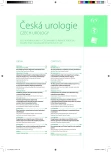Parameters of spermiogenesis and their dynamics in hemodialysis patiens younger than 49 years on waiting list for kidney transplantation
Authors:
Roman Zachoval 1; Jaroslav Jarabák 1; Janka Slatinská 2; Marcela Bürgelová 2; Vladimír Sobotka 3; Jana Vránová 4
Authors‘ workplace:
Urologické oddělení, Thomayerova nemocnice, Praha
1; Klinika nefrologie, Institut Klinické a Experimentální Medicíny, Praha
2; Sanatorium Pronatal, Praha
3; Ústav lékařské biofyziky a lékařské informatiky, 3. lékařská fakulta UK, Praha
4
Published in:
Ces Urol 2012; 16(3): 171-179
Category:
Original article
Overview
Aim:
To evaluate the presence of abnormalities in serum hormone levels and semen analysis in patients under 49 years of age with chronic kidney disease (CKD) awaiting renal transplantation, and correlate the duration of haemodialysis and abnormalities with semen analysis.
Methods:
All male patients, age 18 to 49 with CKD on haemodialysis, awaiting kidney transplant, treated in cooperating haemodialysis centers, between September 2009 and April 2011, that met inclusion criteria, were included in the study. The causes of CKD were identified, and duration of haemodialysis was recorded. The following tests were performed: semen analysis, serum levels of testosterone, SHBG, LH, FSH and prolactin. The control group consisted of men between 18 and 49 years of age, who were investigated during the same period due to urolithiasis. Controls underwent the same testing as the study group. Serum hormone levels and semen analysis parameters were compared between control and study groups. In addition, the same parameters were correlated with the duration of haemodialysis in the group of patients with CKD. Parameters were expressed as mean ± standard deviation.
Results:
The study group consisted of 74 males, mean age 40 ± 7.5 and the control group consisted of 41 males, mean age 36.7 ± 8.8. The average duration of CKD for the research participants was 130.4 ± 87.7 months and the average duration of haemodialysis was 48.8 ± 41.7 months. Average serum testosterone levels were lower in CKD patients then in the control group. CKD patients were found to have significantly higher serum levels of SHBG, LH, FSH and prolactine, and significantly lower volume of ejaculate, total sperm count, sperm concentration, total and progressive sperm motility and sperm morphology. Within the group of patients a negative correlation between serum levels of testosterone and PRL, and a positive correlation between serum levels of LH and FSH as well as between serum levels of testosterone and total sperm motility and morphology was documented. A negative correlation was detected between the duration of haemodialysis and testosterone levels, sperm concentration, total and progressive motility and sperm morphology.
Conclusion:
Significant changes in serum hormone levels and impaired semen analysis parameters were found in haemodialyzed patients waiting for kidney transplantation. The severity of these changes was proportionate to the duration of haemodialysis. Early kidney transplantation could therefore prevent significant deterioration of fertility.
Key words:
chronic kidney disease, haemodialysis, kidney transplantation, semen analysis, serum hormone levels.
Sources
1. Ročenka dialyzační léčby v ČR za rok 2010. http://www.nefrol.cz/resources/upload/data/274_Rocenka2010.pdf
2. WHO laboratory manual for the examination and processing of human semen. Fifth edition, 2010.
3. Viklický O. Chronické selhání ledvin a uremický syndrom. In: Tesař V, Schück O a kol. Klinická nefrologie. Praha: Grada Publishing 2006; 478.
4. Bellinghieri G, Santoro D, Mallamace A, Savica V. Sexual dysfunction in chronic renal failure. J Nephrol 2008; 21 (Suppl 13): S113–117.
5. Vecchio M, Navaneethan SD, Johnson DW, et al. Treatment options for sexual dysfunction in patients with chronic kidney disease: a systematic review of randomized controlled trials. Clin J Am Soc Nephrol 2010; 5(6): 985–995.
6. Hou SH, Grossman S, Molitch ME. Hyperprolactinemia in patients with renal insufficiency and chronic renal silure requiring hemodialysis or chronic ambulatory peritoneal dialysis. Am J Kidney Dis 1985; 6(4): 245–249.
7. Bry-Gauillard H, Touraine P, Mamzer-Bruneel MF, et al. Complete regression of a major hyperprolactinaemia after renal transplantation. Nephrol Dial Transplant 1999; 14(2): 466–468.
8. Stárka L, Zamrazil V, a kol. Základy klinické endokrinologie. 2. vydání. Praha: Maxdorf 2005.
9. Tonelli M, Wiebe N, Knoll G, et al. Systematic review: kidney transplantation compared with dialysis in clinically relevant outcomes. Am J Transplant 2011; 11(10): 2093–2109.
10. Favi E, Salerno MP, Romagnoli J, Castagneto M, Citterio F. Significant improvement in patient survival after renal transplantation in the last decade. Transplant Proc 2011; 43(1): 285–287.
11. Xu LG, Yang YR, Wang HW, et al. Characteristics of male fertility after renal transplantation. Andrologia 2011; 43(3): 203–207.
12. de Celis R, Pedrón-Nuevo N. Male fertility of kidney transplant patiens with one to ten years of evolution using a conventional immunosuppressive regimen. Arch Androl 1999; 42(1): 9–20.
13. Akbari F, Alavi M, Esteghamati A, et al. Effect of renal transplantation on sperm quality and sex hormone levels. BJU Int 2003; 92(3): 281–283.
14. Zuber J, Anglicheau D, Elie C, et al. Sirolimus may reduce fertility in male renal transplant recipients. Am J Transplant 2008; 8(7): 1471–1479.
15. Baumgarten SR, Lindsay GK, Wise GJ. Fertility problems in the renal transplant patient. J Urol 1977; 118(6): 991–993.
Labels
Paediatric urologist Nephrology UrologyArticle was published in
Czech Urology

2012 Issue 3
Most read in this issue
- Predictive factors for prostate cancer detection using saturation prostate biopsy
- The role of pad tests in evaluation of urinary incontinence
- Non seminoma germ cell tumor (NSGCT) in a non-compliant patient
- The first experience with unilateral barbed suture V-Loc in laparoscopic radical prostatectomy
